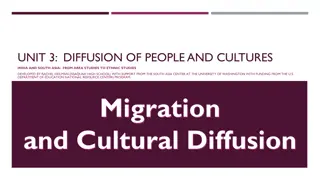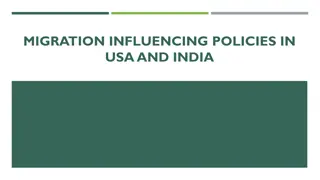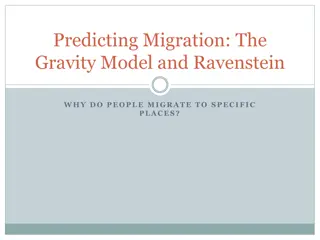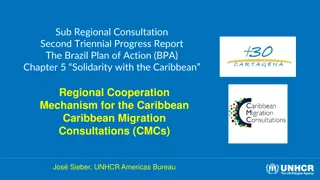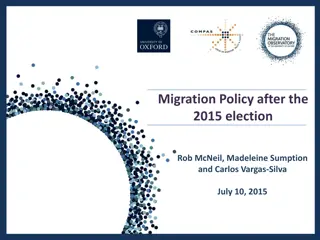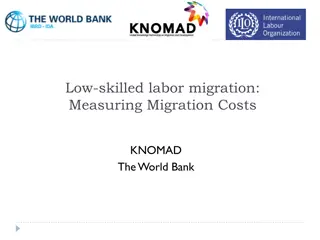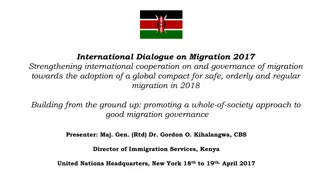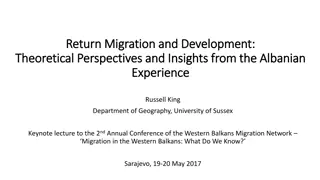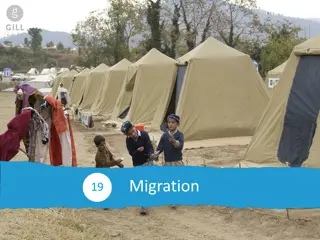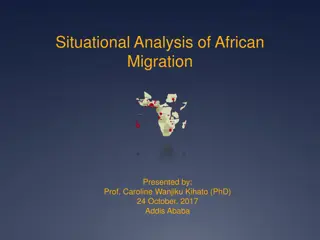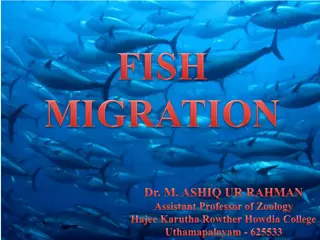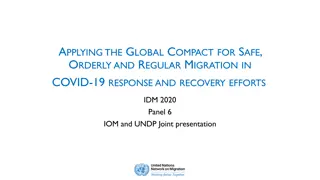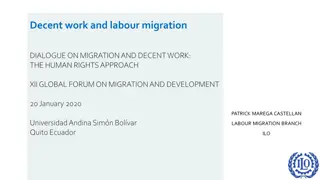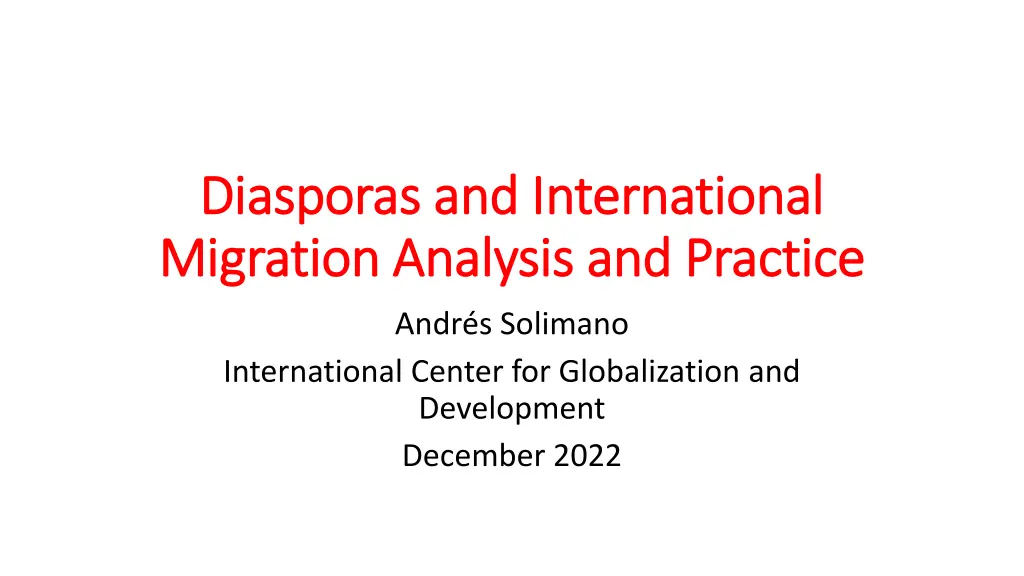
Analysis of Global Migration, Diasporas, and International Mobility Trends
"Explore the dynamics of global migration, diasporas, and international mobility, focusing on key determinants, main trends, and policy considerations. Gain insights into the factors shaping international migration flows and the impact on various regions and economies."
Download Presentation

Please find below an Image/Link to download the presentation.
The content on the website is provided AS IS for your information and personal use only. It may not be sold, licensed, or shared on other websites without obtaining consent from the author. If you encounter any issues during the download, it is possible that the publisher has removed the file from their server.
You are allowed to download the files provided on this website for personal or commercial use, subject to the condition that they are used lawfully. All files are the property of their respective owners.
The content on the website is provided AS IS for your information and personal use only. It may not be sold, licensed, or shared on other websites without obtaining consent from the author.
E N D
Presentation Transcript
Diasporas and International Diasporas and International Migration Analysis and Practice Migration Analysis and Practice Andr s Solimano International Center for Globalization and Development December 2022
Agenda Stylized facts on global migration and Diasporas Overview of main determinants International migration of elites. A) Mobility of the wealthy. B) Mobility of Talent Migration , macroeconomic cycles and recessions Inequality and migration Forced migration: refugees, asylum seekers, humanitarian crises
Stylized Facts (UN-DESA, population division, 2020) Global migration of 278 million in 2020 (3.6 percent of global population) compared to 173 million in 2000 and 221 million in 2010. 65 percent of the international migrants (IM) live in high-income countries (south-north migration), advanced, 31 percent in middle-income countries and 4 percent in low-income economies. Most international migrants come from middle income countries (75 percent). Nearly one-half of the migrants reside in countries of the same region they emigrated. 70 percent of people born in Europe that are IM reside in Europe (north-north migration). This share is 63 percent in Sub-Saharan Africa (south-south migration). Main recipient-countries : USA (51 million IM, 18 percent of total)
Stylized Facts of Main Diasporas (UN-DESA, population division, 2020) cont. Germany (16 million), Saudi- Arabia (13 million), Russian Federation (12 million ), UK (9 million). Main international diasporas: India (18 million) Mexico and Russian Federation (11 million) China (10 million) Syria (8 million) Venezuela (5.9 million).
Main Determinants of International Migration Flows (canonical framework) A list of determinants of migration that involve economic, social, and policy variables: per capita income, developmental gaps and wage differentials between sending and receiving countries; unemployment and informality in labor markets in the sending and receiving nations; cross-country differences in the phase of the economic cycle; family and social networks that share information on job opportunities in the country of immigration;
Main Determinants of International Migration Flows (canonical framework) cont. immigration policies, including incentives and restrictions to the international mobility of people of different skills; cost of migration (distance, cost of traveling, legal costs, search costs); and differences in the quality of cities and availability of social services to migrants and their families in receiving countries. Conflict, humanitarian crises, violence, human rights violations, natural disasters. Refugees, asylum seekers, displaced population. This is often referred to as forced migration or forcibly displaced population .
Diaspora and International Mobility of Elites Mobility of the Wealthy; globally there is around 56 million HNWI (High Net Worth Individuals, with net wealth over USD 1 million, 2020). This represents 1.1 percent of the world s total adult population. Around 50,000 move internationally to reside in other destinations every year. Mobility of Talent ; 30 million migrants with higher education
Mobility of the Wealthy Attitude surveys applied to wealthy individuals highlight the following list of factors the wealthy consider for choosing a country to establish a residence for them and their families: personal safety availability of high-quality health services favorable tax treatment protection of wealth and property rights and good financial systems good education opportunities for the children visa-free mobility to third countries cosmopolitan settings and good transport connections
Mobility of Talent: Types A three-way typology of talent allocation within and across countries was developed (Solimano, 2008): (i) talent engaged in directly productive activities (managers, engineers, skilled workers) (ii) talent devoted to scientific, training, and academic endeavors in the university sector (scholars, academics, and international students), and (iii) talent allocated to the health sector and the cultural sector (medical doctors and nurses, writers, painters, singers).
Global Circuits of Talent Diaspora Mobility We can identify five circuits in which global talent mobility takes place: the international corporate sector chiefly comprising multinational companies and international banks (CEOs, managers) the independent private sector (professionals, experts, cultural workers) the academic sector-universities (scholars, scientists, international students) the international public sector (UN, World Bank, OECD, IMF, etc.) the global civil social society (foundations and NGOs)
Diaspora, Macroeconomic Cycles and Recessions Diaspora, Macroeconomic Cycles and Recessions Economic and financial crises and their aftermath can affect migration flows through three main channels: (a) Slower/negative economic growth, employment, and real wages in receiving countries and thus reducing the incentives for immigration; (b) greater incentive for return migration to the origin country; and (c) a slowdown in the level of remittances that migrants send back home. Global remittances fell from USD 548 billion in 2019 to USD 470 billion in 2021, -14 percent decline.
Episodes. The global financial crisis of 2008-09. The covid crisis of 2021-2022 (fall of international migration of 2-3 million, globally, during 2020). Latin American debt crisis of the 1980s. East Asian crisis of 1997-98. Lebanon, 2020-21.
Inequality and Migration A relevant distinction is: Inequality within countries (internal inequality) and Inequality between countries (international inequality) In general, immigration tends to amplify internal inequality in recipient countries between capital and labor by increasing the supply of labor and therefore moderating the growth of wages relative to profits and the returns on capital assets. Conversely, emigration by making labor and human capital scarcer in the home country tends to increase real wages, thus improving functional income distribution in sending nations. Political economy implications Reaction against immigration perceived as responsible for reducing the wages of locals and taking their jobs (the argument is disputable as many low-level jobs taken by immigrants are not wanted by nationals).
Forcibly Displaced Population Worldwide, Forcibly Displaced Population Worldwide, 2020 2020 (UNHRC) (UNHRC) 82.4 million of forcibly displaced population worldwide , Of which: Internally displaced population (48 million) Refugees (26.4 million) Asylum seekers (4.1 million) Venezuelan displaced abroad (5.9 million, migrants, refugees and asylum seekers).
Humanitarian Crises: Origin and Host Countries for Refugees Diaspora Origin countries (refugees): Syria (6.7 million) Venezuela (4 million) South Sudan (2.2 million) Myanmar (1.2 million) Host countries (refugees) Turkey (3.7 million) Colombia (1.7 million) Pakistan (1.4 million), Uganda (1.4 million), Germany (1.2 million).


